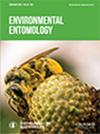Continental-scale migration patterns and origin of Helicoverpa zea (Lepidoptera: Noctuidae) based on a biogeochemical marker
IF 1.8
3区 农林科学
Q2 ENTOMOLOGY
引用次数: 0
Abstract
Insect migrations have ecological and economic impacts, particularly in agriculture. However, there is limited knowledge about the migratory movements of pests at the continental scale, which is an important factor influencing the spread of resistance genes. Understanding the migratory patterns of economic pests, like Helicoverpa zea (Boddie), is essential for improving Integrated Pest Management (IPM) and Insect Resistance Management (IRM) strategies. In this study, we used stable hydrogen isotopic ratios in wing tissue as a biogeochemical marker to examine migratory patterns and estimate the native origins of H. zea individuals collected across a wide latitudinal gradient in North America. Samples collected at higher latitudes (Ontario, Canada and Minnesota, USA) exhibited a greater proportion (60%–96%) of nonlocal individuals, with an increased probability of origin from the southeastern United States. Populations from mid-latitudes (Florida, North Carolina, and South Carolina) showed a blend of local and nonlocal (40%–60%) individuals. Finally, 15% of the southernmost population individuals (Puerto Rico) were classified as migratory, with some having a probability of origin at higher latitudes (>30°). Overall, our results provide evidence of a northward spring/summer migration of H. zea in North America and underscore the significance of the southeastern United States as a hub for genetic flow. In addition, based on stable hydrogen isotopic ratios, there is strong evidence of reverse (southward) migration of H. zea from the continental United States to Puerto Rico. Our study highlights the implications for IPM and IRM programs and the need for management strategies that account for both northward and southward migration patterns.基于生物地球化学标记的 Helicoverpa zea(鳞翅目:夜蛾科)的大陆尺度迁移模式和起源
昆虫迁徙会对生态和经济产生影响,尤其是在农业领域。然而,人们对害虫在大陆范围内的迁徙活动了解有限,而这是影响抗性基因传播的一个重要因素。了解经济害虫(如玉米螟)的迁徙模式对于改进害虫综合治理(IPM)和昆虫抗性管理(IRM)战略至关重要。在这项研究中,我们使用翅组织中的稳定氢同位素比值作为生物地球化学标记来研究迁徙模式,并估计在北美宽纬度梯度上收集到的 H. zea 个体的原产地。在高纬度地区(加拿大安大略省和美国明尼苏达州)采集的样本显示出更大比例(60%-96%)的非本地个体,来自美国东南部的可能性更大。来自中纬度地区(佛罗里达州、北卡罗来纳州和南卡罗来纳州)的种群混合了本地和非本地个体(40%-60%)。最后,最南端种群(波多黎各)中有 15% 的个体被归类为迁徙型,其中一些个体的原产地可能在更高纬度(30°)。总之,我们的研究结果提供了北美 H. zea 春夏季向北迁移的证据,并强调了美国东南部作为基因流动中心的重要性。此外,根据稳定的氢同位素比率,有确凿证据表明 H. zea 从美国大陆向波多黎各反向(南向)迁移。我们的研究强调了 IPM 和 IRM 计划的意义,以及考虑到北向和南向迁移模式的管理策略的必要性。
本文章由计算机程序翻译,如有差异,请以英文原文为准。
求助全文
约1分钟内获得全文
求助全文
来源期刊

Environmental Entomology
生物-昆虫学
CiteScore
3.90
自引率
5.90%
发文量
97
审稿时长
3-8 weeks
期刊介绍:
Environmental Entomology is published bimonthly in February, April, June, August, October, and December. The journal publishes reports on the interaction of insects with the biological, chemical, and physical aspects of their environment. In addition to research papers, Environmental Entomology publishes Reviews, interpretive articles in a Forum section, and Letters to the Editor.
 求助内容:
求助内容: 应助结果提醒方式:
应助结果提醒方式:


